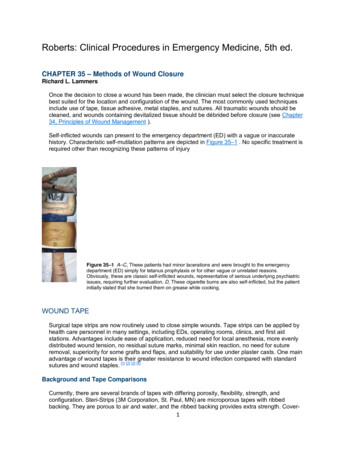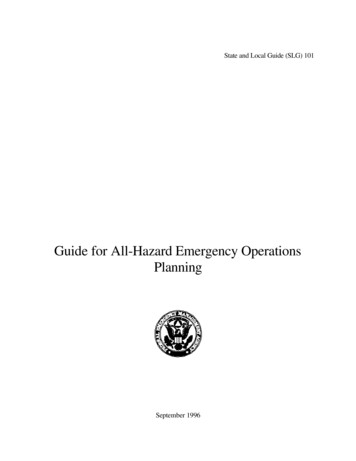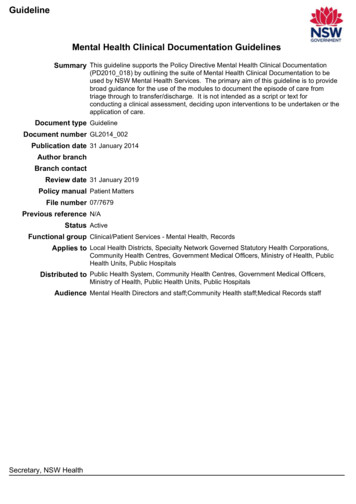
Transcription
Roberts: Clinical Procedures in Emergency Medicine, 5th ed.CHAPTER 35 – Methods of Wound ClosureRichard L. LammersOnce the decision to close a wound has been made, the clinician must select the closure techniquebest suited for the location and configuration of the wound. The most commonly used techniquesinclude use of tape, tissue adhesive, metal staples, and sutures. All traumatic wounds should becleaned, and wounds containing devitalized tissue should be débrided before closure (see Chapter34, Principles of Wound Management ).Self-inflicted wounds can present to the emergency department (ED) with a vague or inaccuratehistory. Characteristic self-mutilation patterns are depicted in Figure 35–1 . No specific treatment isrequired other than recognizing these patterns of injuryFigure 35–1 A–C, These patients had minor lacerations and were brought to the emergencydepartment (ED) simply for tetanus prophylaxis or for other vague or unrelated reasons.Obviously, these are classic self-inflicted wounds, representative of serious underlying psychiatricissues, requiring further evaluation. D, These cigarette burns are also self-inflicted, but the patientinitially stated that she burned them on grease while cooking.WOUND TAPESurgical tape strips are now routinely used to close simple wounds. Tape strips can be applied byhealth care personnel in many settings, including EDs, operating rooms, clinics, and first aidstations. Advantages include ease of application, reduced need for local anesthesia, more evenlydistributed wound tension, no residual suture marks, minimal skin reaction, no need for sutureremoval, superiority for some grafts and flaps, and suitability for use under plaster casts. One mainadvantage of wound tapes is their greater resistance to wound infection compared with standardsutures and wound staples. [1] [2] [3] [4]Background and Tape ComparisonsCurrently, there are several brands of tapes with differing porosity, flexibility, strength, andconfiguration. Steri-Strips (3M Corporation, St. Paul, MN) are microporous tapes with ribbedbacking. They are porous to air and water, and the ribbed backing provides extra strength. Cover-1
Strips (Beiersdorf, South Norwalk, CT) are woven in texture and have a high degree of porosity.They allow not only air and water but also wound exudates to pass through the tape. Shur-Strip(Deknatel, Inc, Floral Park, NY) is a nonwoven microporous tape. Clearon (Ethicon, Inc, Somerville,NJ) is a synthetic plastic tape whose backing contains longitudinal parallel serrations to permit gasand fluid permeability. An iodoform-impregnated Steri-Strip (3M Corporation) is intended to furtherretard infection without sensitization to iodine.[3] Other tape products include Curi-Strip (Kendall,Boston), Nichi-Strip (Nichiban Co., Ltd, Tokyo), Cicagraf (Smith & Nephew, London), and SutureStrip (Genetic Laboratories, St. Paul, MN).Scientific studies of wound closure tapes provide some comparisons of products. Koehn[5] showedthat the Steri-Strip tapes maintained adhesiveness about 50% longer than Clearon tape.Rodeheaver and coworkers[6] compared Shur-Strip, Steri-Strip, and Clearon tape in terms ofbreaking strength, elongation, shear adhesion, and air porosity. The tapes were tested in both dryand wet conditions. The Steri-Strip tape was found to have about twice the breaking strength of theother two tapes in both dry and wet conditions; there was minimal loss of strength in all tapes whenwetted. The Shur-Strip tapes showed approximately two to three times the elongation of the othertapes at the breaking point, whether dry or wet. Shear adhesion (amount of force required todislodge the tape when a load is applied in the place of contact) was slightly better for the Shur-Striptape than for the Steri-Strip tape and approximately 50% better than for the Clearon tape. Of thesethree wound tapes, the investigators considered Shur-Strips to be superior for wound closure.One comprehensive study of wound tapes compared Curi-Strip, Steri-Strip, Nichi-Strip, Cicagraf,Suture Strip, and Suture Strip Plus.[7] All tapes were 12 mm wide except for Nichi-Strip, which was15 mm. Each tape was compared for breaking strength, elongation under stress, air porosity, andadhesiveness. Curi-Strip, Cicagraf, and Steri-Strip exhibited equivalent dry breaking strengths.However, when wet (a condition that can occur in the clinical setting), Cicagraf outperformed alltapes. All of the tested tapes had similar elongation-under-stress profiles with the exception ofSuture Strip Plus. This tape did not resist elongation under low or high forces. Excessive elongationmay allow wound dehiscence. Nichi-Strip was the most porous to air, and Cicagraf was almostvapor-impermeable. Nichi-Strip and Curi-Strip had the best adherence to untreated skin. When theskin was treated with tincture of benzoin, however, Steri-Strip dramatically outperformed all otherproducts. When all study parameters were considered, Nichi-Strip, Curi-Strip, and Steri-Stripachieved the highest overall performance rankings.IndicationsThe primary indication for tape closure is a superficial straight laceration under little tension. Ifnecessary, tension can be reduced by placing deep closures. Areas particularly suited for tapeclosure are the forehead, chin, malar eminence, thorax, and nonjoint areas of the extremities. Tapealso may be preferred for wounds in anxious children when suture placement is not essential. Inyoung children who are likely to remove tapes, tape closures must be protected with an overlyinggauze bandage.In experimental wounds inoculated with Staphylococcus aureus, tape-closed wounds resistedinfection better than wounds closed with nylon sutures.[2] Tape closures work well under plastercasts when superficial suture removal would be delayed. Tape closures effectively hold flaps andgrafts in place, particularly over fingers, the flat areas of the extremities, and the trunk ( Fig. 35–2 ).[3] [4]Wounds on the pretibial area are difficult to close, especially in the elderly because of tissueatrophy. Wound tapes provide an alternative to suture closure in this situation. Tape closures can beapplied to wounds after early suture removal, particularly on the face, to maintain wound edgeapproximation while reducing the chance of permanent suture mark scarring. Finally, because of theminimal skin tension created by tapes, they can be used on skin that has been compromised byvascular insufficiency or altered by prolonged use of steroids.2
Figure 35–2 A, A skin avulsion in the elderly following minor trauma is an ideal wound to closewith closure tapes, as such injuries cannot be closed with sutures. The goal is to provideapproximation of the avulsed skin and apply pressure to avoid skin flap movement or fluidaccumulation under the avulsion. Tissue glue can augment this procedure. An elderly womanwho was on steroids had extremely thin skin and suffered a skin avulsion that could not bereplaced with sutures. B, The skin edges are uncurled, stretched, and anatomically replaced. C,The wound should heal when closure tapes keep the skin in place. Tissue glue (Dermabond )was also dabbed on various parts of the edges, allowing for fluid egress. D, A compressiondressing, such as an elastic bandage or a Dome paste (Unna) boot dressing, can be applied tominimize flap movement and decrease fluid buildup under the flap. E and F, Large avulsionreplaced with Steri-Strips and tissue glue. Tape should be placed in a semicircular or spiralpattern on digits to avoid constriction. G, After suturing this proximal-based flap, Steri-Strips areapplied under a tourniquet, compressing the flap to arrest flap motion and lessen fluid buildup.ContraindicationsTape closures have disadvantages. Tape does not work well on wounds under significant tension oron wounds that are irregular, on concave surfaces, or in areas of marked tissue laxity. In manycases, tape does not provide satisfactory wound edge apposition without concurrent underlyingdeep closures. Tape does not stick well to naturally moist areas, such as in the axilla, the palms ofthe hands, the soles of the feet, and the perineum. Tape also has difficulty adhering to wounds thatwill have secretions, copious exudates, or persistent bleeding. They are of little value on lax andintertriginous skin, in the scalp, and in other areas with high concentration of hair follicles. Tapestrips are also at risk for premature removal by young children.Tapes should not be tightly placed circumferentially around digits because they have insufficientability to stretch or lengthen. If placed circumferentially, the natural wound edema of an injured digitcan make the tape act like a constricting band, which can lead to ischemia and possible necrosis ofthe digit. Semicircular or spiral placement techniques should be used if digits are to be taped.3
EquipmentFor a simple tape closure, the required equipment includes forceps and tape of the proper size.Most taping can be done in the ED with-x 3-inch strips. In wounds larger than 4 cm,-inch-wide strips provide greater strength. Most companies manufacture stripshowever,up to 1 inch wide and up to 4 inches long.ProcedureProper wound preparation, irrigation, débridement, and hemostasis must precede tape closures.Fine hair may be cut short or shaved, and the area of the tape application is thoroughly dried toensure proper adhesion. Attempting to apply tapes to a wet area or over a wound that is slowlyoozing blood will usually result in failure of the tapes to stick to the skin. On fingers, tapes can beapplied to a wound that is kept dry by a tourniquet temporarily placed at the base of the finger (seeFig. 35–2G ).The technique of applying tapes is shown in Figure 35–3 . After the wound has been dried, a liquidadhesive such as tincture of benzoin or Mastisol can be applied to the skin adjacent to the wound toincrease tape adhesion.[2] All tapes come in presterilized packages and can be opened directly ontothe operating field. Tapes should be handled with gloved hands. With backing still attached, tapesare cut to the desired length or long enough to allow for approximately 2 to 3 cm of overlap on eachside of the wound. After the end tab is removed, the tape is gently removed from its backing withforceps by pulling straight back. Do not pull to the side, because the tape will curl and will be difficultto apply to the wound. One half of the tape is securely placed at the midportion of the wound. Theopposite wound edge is gently but firmly apposed to its counterpart. The second half of the tape isthen applied. The wound edges should be as close together as possible and at equal height toprevent the development of a linear, pitted scar. Additional tapes are applied by bisecting theremainder of the wound. A sufficient number of tape strips should be placed so that the wound iscompletely apposed without totally covering the entire length of the wound. Finally, additional crosstapes are placed to add support and prevent blistering caused by unsupported tape ends.[1]Figure 35–3 Proper technique for application of tapes for skin closure. A, After woundpreparation (and placement of deep closures, if needed), dry the skin thoroughly at least 2 inchesaround the wound. Failure to dry the skin and failure to obtain perfect hemostasis are commoncauses of failure of tapes to stick to the skin. B, If desired, apply a thin coating of tincture ofbenzoin around the wound to enhance tape adhesiveness. Benzoin should not enter the eye, asit causes pain if it seeps into an open wound. C, Cut the tapes to the desired length beforeremoving the backing. D, The tapes are attached to a card with perforated tabs on both ends.Gently peel the end tab from the tapes. E, Use forceps to peel the tape off the card backing. Pulldirectly backward, not to the side. F, Place half of the first tape at the midportion of the wound;secure firmly in place. G, Gently but firmly appose the opposite side of the wound, using the freehand or forceps. If an assistant is not available, the operator can approximate the wound edges.The tape should be applied by bisecting the wound until the wound is closed satisfactorily. H,Wound margins are completely apposed without totally occluding the wound. I, Additionalsupporting tapes are placed approximately 2.5 cm from the wound and parallel to the wounddirection. Taping in this manner prevents the skin blistering that may occur at tape ends.4
Taped wounds are not covered with occlusive dressings. Adhesive bandages (e.g., Band-Aids) andother impermeable dressings promote excessive moisture, which can lead to premature separationof tape strips from the wound. An adhesive bandage also may adhere to the tapes, pulling them offthe skin at the time of the dressing change. Tapes may remain in place for approximately 2 weeksor longer, if necessary. The patient can be allowed to clean the taped laceration gently with a slightlymoist, soft cloth after 24 to 48 hours. However, if excessive wetting or mechanical force is used,premature tape separation may result. Patients may be instructed to gently trim curled edges of theclosure tape with fine scissors to avoid premature loss of the tape.ComplicationsComplications are uncommon with tape closure. The wound infection rate in clean wounds closedwith tape compares favorably with rates for other standard closures.[1] However, some investigatorsbelieve that tape closure leads to inferior cosmetic results.[8] Premature tape separation occurs inapproximately 3% of cases.[6] Other complications include (1) skin blistering, which occurs if the tapeis not properly anchored with the cross strip or the tape is stretched too tightly across the wound,and (2) wound hematoma, which results if hemostasis is inadequate. Tape may loosen prematurelyover shaved areas as hair grows back.When tincture of benzoin is used, it should be applied carefully to the surrounding, uninjured skin. Ifspillage occurs into the wound, the wound is at higher risk for infection.[9] Benzoin vapors cause painwhen applied near an open wound that has not been anesthetized. Benzoin can also injure theconjunctival and corneal membranes of the eye.SummaryModern tape products and techniques serve a valuable role in minor wound management of EDpatients. Tape closure in selected wounds is as successful as suture closure. [1] [10] Closure tapesshould be considered for superficial wounds in cosmetically unimportant areas and for wounds onrelatively flat surfaces that are too wide for simple dressings but do not require sutures.TISSUE ADHESIVE (TISSUE GLUE)Tissue adhesive (also called tissue “glue”) provides a simple, rapid method of wound closure.Tissue adhesive has been approved for use in the United States since 1998. Two types of tissueadhesives are available: N-2-octylcyanoacrylate (Dermabond, Ethicon, Inc) and N-butyl-2cyanoacrylate (Indermil, Tyco Healthcare Group LP). Dermabond and Indermil are packaged insterile, single-use ampules. These bonding agents can be used on superficial wounds, even in hairbearing areas. Tissue adhesives polymerizes on contact with water. These substances arebiodegradable but remain in the wound until well after healing.[11]ProcedureTissue adhesive can be used to approximate wounds not requiring deep-layer closure. Inpreparation for closure, the wound should be anesthetized and cleaned and, when necessary,débrided. Bleeding must be controlled.As the wound edges are held together with forceps, gauze pads, or fingers, a small, cylindricalplastic container is squeezed to expel droplets of tissue adhesive through a cotton applicator tip atthe end of the container. The adhesive is applied in at least three to four thin layers along the lengthof the wound's surface and extending about 5 to 10 mm from each side of the wound ( Fig. 35–4 ).Alternatively, one can place the adhesive in strips perpendicular to the laceration (analogous toplacement of closure tapes). The purple color of the solution facilitates placement of the droplets.The wound edges should be supported, with edges held together, for at least 1 minute while the5
adhesive dries. The low-viscosity tissue adhesives may seep into the wound or trickle off roundedsurfaces during application. This tendency toward migration or “runoff” can be minimized by usinghigh-viscosity adhesives,[12] positioning the wound horizontally, or slowly applying the adhesive.Runoff can be contained with wet gauze or by creating a barrier of petrolatum.Figure 35–4 A, Tissue adhesive, 2-octylcyanoacrylate, comes in a variety of commerciallyavailable dispensers. B, To apply tissue adhesive (glue), the laceration must be dry. Highviscosity glue limits runoff. C, Bring the edges together, using a gauze pad or fingers, and applyglue in a few layers, with drying between applications. Do not get the glue in the eyes. D, Nearthe eye, keep the patient supine and tilt the head to avoid eye contamination and apply a layer ofpetroleum jelly as a barrier to the glue entering the eye. Do not apply the jelly to the area wherethe tissue adhesive must adhere. E, Alternatively, use a gauze barrier. If the adhesive enters theeye or lids, wipe it off with the gauze and flush with saline. Lids glued shut may be loosened withantibiotic ointment/petroleum jelly. If unsuccessful, tell the patient to shower normally and the eyewill open in a few days as the glue sloughs off the lid. Note: Glue that touches a latex glove,gauze, or plastic instrument (but not vinyl gloves or metal instruments) will glue them to thepatient.Wound closures with tissue adhesive can be reinforced by pulling the wound edges into appositionwith a few strips of porous surgical tape before the application of the adhesive. Tissue adhesive canbe placed on top of surgical tape, but tape should not be placed on top of dried tissue adhesive.Once the adhesive has dried completely, the closure can be further protected with a nonocclusivebandage.The primary advantage of tissue adhesive is the speed of closure. Wounds can be closed in as littleas one sixth of the time required for repair with sutures. Application is rapid and painless. Use oftissue adhesive avoids suture marks adjacent to the wound and reduces the risk of needle stickinjuries to health care personnel. Wounds closed with tissue adhesive have less tensile strengththan sutured wounds in the first 4 days, [13] [14] but 1 week after closure, the tensile strength andoverall degree of inflammation in wounds closed with tissue adhesive were equivalent to thoseclosed with sutures. [11] [15] Cosmetic results are similar to those obtained with suture repair. [14] [16] [17][18] [19] [20] [21] [22]Tissue adhesive serves as its own wound dressing and has an antimicrobial effectagainst gram-positive organisms. [23] [24] The material sloughs off in 5 to 10 days, thereby saving thepatient from a clinician visit. Ointments or occlusive bandages should not be placed on woundsclosed with tissue adhesive.6
ComplicationsPercutaneous sutures provide a more secure immediate closure than tissue adhesive.[11] Althoughtissue adhesive is classified as nontoxic and does not cause a significant foreign body reaction, itshould not be placed within the wound cavity. [14] [15] If hemostasis is inadequate or an excessiveamount of adhesive is applied too quickly, the patient can experience a burning sensation or sustaina local burn from the heat of polymerization. After polymerizing, tissue adhesive can fracture withexcessive or repetitive movement. Although gentle rinsing is permitted, if the adhesive is washed orsoaked, it will peel off in a few days, before the wound is healed.[14]If the clinician's gloved fingers, gauze, or plastic instruments contact the tissue adhesive duringapplication, the glove may adhere to the patient's skin. Tissue adhesive can be removed withantibiotic ointment, petrolatum jelly, or more rapidly with acetone.[22] Indermil must be stored underrefrigeration.One risk involving the use of tissue adhesive is its ease of use—clinicians may fail to adequatelyclean wounds before closure with tissue adhesive.[25] Tissue adhesive should not be used to closeinfected wounds. If the wound edges cannot be held together without considerable tension, tissueadhesive should not be used.[22] Tissue adhesive should not be used near the eyes, over or nearjoints, on moist or mucosal surfaces, or on wounds under significant static or dynamic skin tension.See Figure 35–4 for information on managing eyelids that are accidentally glued shut.SUTURESIn the United States, most traumatic wounds are closed by suturing.EquipmentInstrumentsIn addition to the instruments used for débridement, a needle holder and suture scissors arerequired for suturing. The mechanical performance of disposable needle holders distributed bydifferent surgical instrument companies varies considerably.[40] The size of the needle holder shouldmatch the size of the needle selected for suturing—that is, the needle holder should be largeenough to hold the needle securely as it is passed through tissue, yet not so large that the needle iscrushed or bent by the instrument.Instruments used to débride a grossly contaminated wound should be discarded and replaced byfresh instruments for the closure. Instruments covered with coagulated blood can be cleansed withhydrogen peroxide, rinsed with sterile saline or water, and then used for suturing.Suture MaterialsA wide variety of suture materials are available. For most wounds that require closure of more thanone layer of tissue, the clinician must choose sutures from two general categories: an absorbablesuture for deeper, subcutaneous (SQ) layer and a nonabsorbable suture for surface (percutaneous)closure.Sutures can be described in terms of four characteristics:1.Composition (i.e., chemical and physical properties).2.Handling characteristics and mechanical performance.3.Absorption and reactivity.7
4.Size and retention of tensile strength.CompositionSutures are made from natural fibers (cotton, silk), from sheep submucosa or beef serosa (plain gut,chromic gut), or from synthetic materials such as nylon (Dermalon, Ethilon, Nurulon, Surgilon),Dacron (Ethiflex, Mersilene), polyester (Ti-Cron), polyethylene (Ethibond), polypropylene (Prolene,Surgilene), polyglycolic acid (Dexon), and polyglactin (Vicryl, coated Vicryl). Stainless steel suturesare rarely, if ever, useful in wound closure in the ED setting because of handling difficulty andfragmentation. Some sutures are made of a single filament (monofilament); others consist ofmultiple fibers braided together ( Table 35–1 ).[41]TABLE 35–1 -- Examples of Suture MaterialsAbsorbable SuturesNonabsorbable SuturesMonofilamentDermalon (nylon)Plain gutChromic gutPDS (polydioxanone)Maxon (polyglyconate)Ethilon (nylon)Prolene (polypropylene)SilkSteelSurgilene (polypropylene)Tevdek (Teflon-coated)MultifilamentEthibond (polyethylene)Dexon (polyglycolic acid)Coated Vicryl (polyglactin)Mersilene (braided polyester)Nurulon (nylon)Surgilon (nylon)TiCron (polyester)Handling and PerformanceDesirable handling characteristics in a suture include smooth passage through tissues, ease in knottying, and stability of the knot once tied ( Table 35–2 ). Smooth sutures pull through tissues easily,but knots slip more readily. Conversely, sutures with a high coefficient of friction have better knotholding capacity but are difficult to slide through tissues. Smooth sutures will loosen after the firstthrow of a knot is made, and a second throw is needed to secure the first in place. However, theclinician may want to tighten a knot further after the first throw is made. This is difficult with roughertypes of sutures.8
TABLE 35–2 -- Characteristics of Suture MaterialsKnotTensileTissueSuture MaterialSecurityStrengthReactivityDuration of SutureIntegrity (days)Tie Ability(Handling)AbsorbableSurgical gutPoorFairGreatest5–7PoorChromic gutFairFairGreatest10–14PoorCoated dified with permission from Hollander J, Singer A: Laceration management. Ann Emerg Med 34:351,1999.Multifilament sutures have the best handling characteristics of all sutures, whereas steel sutureshave the worst. In terms of performance and handling, significant improvements have been made inthe newer absorbable sutures. Gut sutures have many shortcomings, including relatively low andvariable strength, a tendency to fray when handled, and stiffness despite being packaged in asoftening fluid. [42] [43] Multifilament synthetic absorbable sutures are soft and easy to tie and havefew problems with knot slippage. Polyglactin 910 (coated Vicryl) sutures have an absorbablelubricant coating. The “frictional drag” of these coated sutures as they are pulled through tissues isless than that of uncoated multifilament materials, and the resetting of knots after the initial throw ismuch easier. This characteristic allows retightening of a ligature without knotting or breakage andwith smooth, even adjustment of suture line tension in running subcuticular stitches.[44] Syntheticmonofilament sutures have the troublesome property of “memory”—a tendency of the filament tospring back to its original shape, which causes the knot to slip and unravel. Some nonabsorbablemonofilament sutures are coated with polytetrafluorethylene (Teflon) or silicone to reduce theirfriction. This coating improves the handling characteristics of these monofilaments but results inpoorer knot security.[43]Three square knots will secure a stitch made with silk or other braided, nonabsorbable materials,and four knots are sufficient for synthetic, absorbable, and nonabsorbable monofilament sutures.[45]Five knots are needed for the Teflon-coated synthetic Tevdek.[46] With the use of coated syntheticsuture materials, attention to basic principles of knot tying is even more important. An excessivenumber of throws in a knot weakens the suture at the knot. If the clinician uses square knots (or asurgeon's knot on the initial throw, followed by square knots) that lie down flat and are tied securely,knots will rarely unravel.[47]9
Absorption and ReactivitySutures that are rapidly degraded in tissues are termed absorbable; those that maintain their tensilestrength for longer than 60 days are considered nonabsorbable (see Table 35–1 ). Plain gut may bedigested by white blood cell lysozymes in 10 to 40 days; chromic gut will last 15 to 60 days.Remnants of both types of sutures, however, have been seen in wounds more than 2 years aftertheir placement. [42] [45] [48] The Ethicon catgut is rapidly absorbed within 10 to 14 days but with lessinflammation than that caused by chromic catgut.[49] Vicryl is absorbed from the wound site within 60to 90 days [42] [45] and Dexon, within 120 to 210 days. [50] [51] When placed in the oral cavity, plain gutdisappears after 3 to 5 days, chromic gut after 7 to 10 days, and polyglycolic acid after 16 to 20days.[52] In contrast, SQ silk may not be completely absorbed for as long as 2 years.[45] The rate ofabsorption of synthetic absorbable sutures is independent of suture size.[50]Sutures may lose strength and function before they are completely absorbed in tissues. Braidedsynthetic absorbable sutures lose nearly all of their strength after about 21 days. In contrast,monofilament absorbable sutures (modified polyglycolic acid [Maxon, Davis & Geck] andpolydioxanone [PDS, Ethicon]) retain 60% of their strength after 28 days. [53] [54] Gut sutures treatedwith chromium salts (chromic gut) have a prolonged tensile strength; however, all gut sutures retaintensile strength erratically. [42] [45] Of the absorbable types of sutures, a wet and knotted polyglycolicacid suture is stronger than a plain or chromic gut suture subjected to the same conditions. [43] [55]Polypropylene remains unchanged in tissue for longer than 2 years after implantation.[56] Incomparison testing, sutures made of natural fibers such as silk, cotton, and gut are the weakest;sutures made of Dacron, nylon, polyethylene, and polypropylene are intermediate in tensilestrength; and metallic sutures are the strongest.[43] The comparison of suture strength versus woundstrength is a measure of the usefulness of a suture. Catgut is stronger than the soft tissue of awound for no more than 7 days; chromic catgut, Dexon, and Vicryl are stronger for 10 to 21 days;and nylon, wire, and silk are stronger for 20 to 30 days.[57]All sutures placed within tissue will damage host defenses and provoke inflammation. Even the leastreactive suture impairs the ability of the wound to resist infection.[56] The magnitude of the reactionprovoked by a suture is related to the quantity of suture material (diameter x total length) placed inthe tissue and to the chemical composition of the suture. Among absorbable sutures, polyglycolicacid and polyglactin sutures are least reactive, followed by chromic gut. Nonabsorbablepolypropylene is less reactive than nylon or Dacron. [43] [58] [59] Significant tissue reaction is associatedwith catgut, silk, and cotton sutures. Absorbable polyglycolic acid sutures are less reactive thanthose of nonabsorbable silk.[60] Highly reactive materials should be avoided in contaminatedwounds.The chemical composition of sutures is a factor in early infection. The infection rate inexperimentally contaminated wounds closed with polyglycolic acid sutures is less than the rate whengut sutures are used.[56] However, other authors have compared plain gut and nonabsorbable nylonsutures for skin closures in children and found comparable cosmetic results and infection rates.[61]Lubricant coatings on sutures do not alter suture reactivity, absorption characteristics, breakingstrength, or the risk of infection. [44] [56] Multifilament sutures provoke more inflamma
Roberts: Clinical Procedures in Emergency Medicine, 5th ed. CHAPTER 35 – Methods of Wound Closure Richard L. Lammers Once the decision to close a wound has been made, the clinician must select the closure technique best suited for the location and conf










